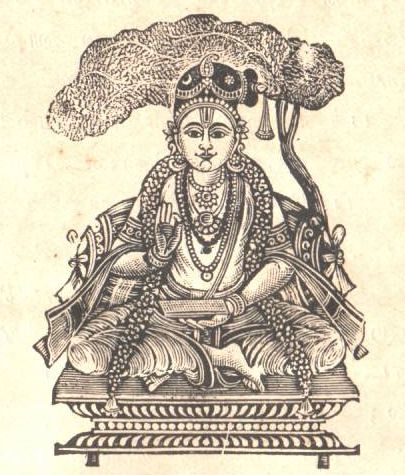
Tiruvaymoli, literally ‘word from mouth’ is a collection of the divine and inspired outpourings of svami nammalvar. It establishes emotionally and experientially the supreme truth to be tirumal (lord sriman narayana). Tiruvaymoli, because of its authoritative foundational quality is called ‘dravida veda’ (pranava) and dravidopanishad (prasthana). Its poetic beauty and divine deities make it a classic.
Tiruvaymoli consists of 1102 verses made up of groups of eleven stanzas each and an additional three stanzas in one group. The decades and the groups are in antadi form in which the first line or word or
Syllable of a stanza begins with the last line or word or syllable of the previous stanza. And the ending of the last verse (1 102) is the beginning of the first verse. Thus tiruvaymoli provides us with may winding bouts of linked sweetness long drawn out. The antadi is also an effective mnemonic. Alliterations,
Assonance, correspondence, rhythm and other sonic devices make tiruvaymoli a veritable store – house of compositions that could be sung to the ragas of karnatic music with their moods of longing, separation, joy, sorrow and so on.
Uniquely favoured by Lord Vishnu, Svami Nammalvar, gifted with matchless powers of poetic composition by the lord himself, supplicates to him to end his transmigratory chain of births and liberate him for ever. In hymn after hymn glowing with emotional stirrings, he has realised the ultimate to be tirumal.
We have five major expositions of Svami Nammalvar masterpiece, whicb are themselves treasures of erudition and God experience. They are collectively called Bbaghavadvishayam(matter relating to Bhagavan, the Lord)
Nammalvar’s Tirumal is the repository of all auspicious attributes, enclosing formlessness within his all-encompassing form. He is transcendent and yet immanent in all the worlds created, preserved and destroyed by hi. In this cosmic wholeness he embodies all the contraries and dualities of existence and all time and space. The alvar’s poetic strains reveal him in this manner as the essence of all experience.
The Alvar’s presentation of his god-experience gains a dramatic dimension as he speaks through imagined women characters, of his interactions with tirumal in terms of relationships between a lady-love and her hero and the reactions thereto, of the lady-love’s mother and friend. These poems in the form of monologues are cast in the old tamil tradition of love-poetry and carry mystic nuances which have been explicated beautifully by srivaishnava preceptors expounding tiruvaymoli in later centuries.

Tiruvaymoli as the srivaishnava book of revelation, has, through five centuries, called forth expositions of its mystic significances, correlating them with parallel utterances of the upanishads, the ithihasas
And the puranas and the agamas besides works in tamil, by acharyas (preceptors).
We have five major expositions of svami nammalvar’s master piece, which are themselves treasures of erudition and godexperience. They are collectively called bhaghavad-vishayam (matter relating to bhagavan, the lord) and the srivaishnava community views their study and cultivation as identical with the experience of tirumal himself. It is also the core text of the dravida (or tamil) vedanta.
There are also many commentaries and translations of the work in non-tamil indian languages from nepal to kerala. In temples of the srivaishnava faith a separate annual festival of recitation of tiruvaymoli is held, the end-portion of which re-enacts the ascension of svami nammalvar to sri vaikuntha with the chanting of the two concluding poems of his master-piece.
The other works of svami nammalvar
Nammalvar’s works are four in number: a) tiruviruttam b) tiruvasiriyam C) periya tiruvantadi d)tiruvaymoli. Tiru means all that is auspicious and Good. Viruttam and asiriyam are cwd kinds of poetical metres. Antadi means That kind ofcomposition where the last letter of the first verse is necessarily the First letter of the next. There is a connection berween the end (Anta) and the Beginning (Aadi} and therefore the coinage of the word, antadi. Vaymoli, of course means that which is uttered and when corn bined with the prefix tiru it is interpreted as the divine word. It also means the veda which was learnt by Rote and never committed to writing.
Tiruviruttam – this is a poem having hundred stanzas with each Stanza having four lines. The vernacular name for this kind of verse is Kattalai kaiitturai. The first letters of each line will also rhyme to form a Pattern. Viruttam, besides denoting a kind of verse, also means a message Or an event.
Tiruvasiriyam – this is a poem of s eventy one lines in seven unequal Sections. The first section has fifteen lines, the second, third, fourth and Seventh have nine lines each, the fifth and the sixth have ten lines each. The First fifteen lines of the poem speak of the glory of the lord as he lies on adi Sesha. The second nine lines are in the foxm of an address to god wherein the Saint categorically asserts that the wise will always yearn for god and not fall Into the lure of the pleasures of the world.
Periya Tiruvantadi – it is a poem of eighty-seven stanzas set in the Venba metre. This is also a four-lined verse, in this composition the alvar Addresses his heart in many a verse. Scholars compare the periya tiruvantadi to the tiruvaymoli both in terms uf the range of subjects and the moving Quality of the expressions.
Source:
SrI Nrisimha Priya








Need total tiruvaiemoli in PDF format in telugu